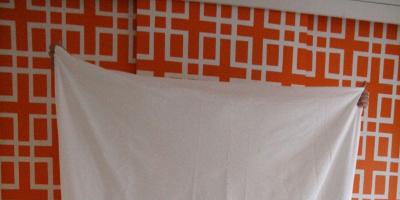Finishing work is never complete without the use of paints and paints. Today, the most popular is acrylic paint, which is a water-dispersion type. It contains water, a coloring pigment and polymer-based binders - acrylic.
Since the paint contains water, it evaporates quite quickly, which leads to the rapid drying of the painted surface. In this case, when the layer dries, it forms a very strong film that cannot be washed off with water. Acrylic has frost-resistant properties; it does not crack, crumble, or delaminate. Therefore, it is customary to use such paint not only for interior finishing works, but also for outdoor ones.
If the purchased volume of paint is not used at once, but is stored for some time in an already opened package or the paint is too thick, there is a need to use an acrylic paint thinner or... a solvent. In fact, these two liquids have slightly different tasks. Let's tell you in more detail.
What is a solvent and a thinner - the main differences
Many people mistakenly believe that solvent for acrylic paints is no different from acrylic thinner. In reality, these concepts are slightly different. If you use both options incorrectly, you will not be able to achieve the desired effect.
In what cases is a solvent and thinner needed:
Attention! In everyday life, thinners are also called solvents, so you must carefully read the instructions before purchasing the product!
How to dilute acrylic paint
Thickened acrylic paint can be diluted in several ways:
- Since this coloring matter contains water, it can be dissolved with the same liquid. But keep in mind that the water must be extremely clean and of high quality, without chemical impurities. To do this, dry paint on water based need to be diluted with water with a construction mixer in a separate container. If you plan to use the entire mixture, dilute it directly in the jar. Water should be added little by little so as not to make the paint too liquid. If your base has a rich tone, then after diluting with water the color will fade a little, so you will have to add a coloring pigment.
- Special thinners-solvents for acrylic paint. A huge number of them are produced. The main advantage is improved coating properties and faster surface drying. In addition, solvents can impart a matte or glossy finish. The thinner is a transparent liquid with a specific odor, which quickly evaporates as the mixture dries.
Features of water use
Before diluting acrylic paint with water, make sure the aqueous liquid is pure. It should also be cold. Be sure to prepare a container for the experiment, in what ratio you need to dilute the paint.
The relationships can be as follows:
- The 1:1 option is used for the base layer. The paint is not too thick, applies evenly, and covers as well as possible.
- Option 1:2 assumes a structure that does not spread and easily saturates a brush or roller. The layer turns out thin and smooth.
- Option 1:5 has a liquid structure, in which the color is practically not retained. In this case, you need to add a coloring pigment. This mixture is most often intended for painting figured and small products. It dries quickly, but you will have to apply many layers.
- The 1:15 option is more reminiscent of regular water with a slight tint. Used to create a smooth color transition - a gradient effect.
Features of using thinners
Solvents intended for acrylic vary in degree of drying:
- Fast speed is used in cold weather conditions. As you know, low temperatures do not allow paint to quickly adhere to the surface. With the help of a thinner this becomes possible.
- Average speed is considered universal. Mainly used for interior work with normal temperature conditions.
- Low speed is used at elevated temperatures. If the water evaporates too quickly, the paint will begin to lose its properties, which should not be allowed. A low rate solvent will reduce the evaporation rate.
The effect of diluted paint directly depends on the proportions of the mixture of the coloring matter and the thinner. So, you can get a transparent surface, a thin layer or a thick one.
When storing, follow the instructions. Be sure to close the lid tightly and place the solvent container vertically. The room temperature should be cool.
The basis of thinners based on the composition of the paint
Thinners for acrylic paints are different based on the main active ingredient:
- Solvent, gasoline and the like. Disappears quickly.
- White Spirit. The evaporation rate is high.
- Kerosene has average speed volatility.
- Turpentine evaporates slowly.
What to do if acrylic paint has dried out?
What to do if yours are dry acrylic paints? After all, quite often after painting there is a little mixture left, and it’s a shame to throw it away. Over time, it begins to thicken greatly. But this is not a reason to be upset, since acrylic, unlike other types of paints, can be restored. Here are some useful and effective recommendations:
- Initially, you need to determine the extent to which the paint has dried. After all, if it dries out a little, it is much easier to restore it.
- If the mixture has not thickened much, but there are already clots, simply dilute it with water or a special thinner. In this case, you can add a little alcohol to the water.
- If the paint has dried out excessively, to the point of hardening, do not be discouraged! The situation can be fixed. So, you need to take a sharp tool and try to crack the hardened areas. Then grind them to a powder. Next, heat the water to a boil and pour it into the jar with the crumbs. After waiting for 20-30 seconds, drain the boiling water and add a new portion of water. Do this 3-4 times. During the last pour, leave the water in the jar and mix with the powdery mass. Such diluted paint has reduced characteristics, but if there is no other option, then you can use it. In order to improve the performance and properties, you can add a very small amount of boiling water, and after mixing, add a factory thinner.
- If acrylic paint has thickened and turned into one solid lump, then it is better to throw it away, because it has practically not retained its properties. However, there are situations when paint is simply necessary. For example, for painting a bench on the street, a table in the country, and so on. In this case, you can revive it in the same way as the previous one. But with the difference that the last time you need to dissolve the crumbled paint not just with boiling water, but with the addition of alcohol.
How to prevent paint from drying out
It is very important to understand why the paint has dried. The fact is that acrylic is based on water, which evaporates a little even when the lid is closed. This in turn leads to polymerization. You need to know that when it dries out, the properties of the mixture also disappear. In order not to bring the stock to this state, you need to follow simple rules:
- It is strictly forbidden to dilute paint or add coloring pigments in a common can. After all, you don’t know whether all the material will be used up. It is better to pour the required amount into a separate container and dilute it in it.
- Remember, water from acrylic evaporates quickly, so close the lid on the tube or jar as tightly as possible. This will slow down the drying process.
- Quite often the lid is glued to the base of the jar. To prevent this, after work, immediately clean the edges of the container from any remaining dye and only then close the lid.
- Do not store paints or paints high temperatures. This helps neutralize moisture and properties.
How to clean acrylic paint
If you need to get rid of dried acrylic paint, you can use a special solvent. This will allow you to spend a minimum of time and do the work better.
Remember, the fresher the stain, the easier it is to get rid of. For example, you can remove stains immediately after painting using plain water. In principle, both brushes and containers are washed simply with warm water.
But if the paint is completely dry, then it acquires moisture-resistant properties, since the water evaporates and a waterproof film is formed. Many people use sandpaper, sharp objects to clean the painted surface. There is no need to do this, because there are special solvents that are applied to the surface. Next, you need to leave the solvent for a few minutes and then easily get rid of the paint!
Solvent for car painting is one of the most important and essential components in painting work. There are a large variety of them and only certain ones are needed to properly dilute the paint. So, in order not to be mistaken about how to dilute paint, acrylic or any other, we will consider the main types of solvents and their use.
In principle, a diluent and a solvent are one substance. Both serve to bring the material to the required viscosity (paint, primer, liquid putty, base enamel, etc.)
The manufacturer always indicates which solvent is best to use for painting a car. Each paint system has its own required hardener and thinner. Be sure to read the instructions on the page before use. back side containers. It will indicate what type of thinner to use, at what temperature and for what material.
It’s worth mentioning right away which solvents should not be used to thin acrylic paint - these are organic 646, 647, 650, etc. When diluting paint or varnish with them, painting difficulties may arise. Use them only for washing or other tools. The price for them is not great for cleaning.

Types of solvents and thinners, which one to choose?
If you have a question, how to dilute acrylic paint? There is only one answer, use any branded one. acrylic solvent. Even if it is from a different brand than the paint, varnish, primer, etc. being mixed. Just don't use the ones mentioned above! Branded acrylic solvent is an order of magnitude more expensive than conventional thinners, but for quality repairs It is recommended to use them.If the branded acrylic has run out or you want to save money, then you can use the domestic manufacturer of material thinner, universal solvent P12. It has been successfully tried on almost all acrylic materials (varnishes, acrylic paint, primers, epoxy substances). There were no problems or defects. It can safely be considered a universal solvent. P12 is “normal.

And so, the main criterion for choosing a thinner for diluting paint is the ambient temperature. Temperature needs to be determined environment before painting and then choose the right one. Temperature affects the drying time of the material. In hot weather, the solvent evaporates faster and the paint does not have time to spread. Defects, large shagreen, and dust appear. IN cold weather Evaporation will be too slow and there will be more debris.
There are three groups of acrylic thinners:
- Slow
- Normal
- Fast
Therefore, for high-quality work, always choose a material at a certain air temperature.
If it is cold, then use a “fast” thinner at a temperature of 5 to 15 degrees. At normal temperature from 15 to 25 “normal” is used. And in hot weather from 25 degrees, a slow one is necessary. All figures are approximate; for exact determination, see the manufacturer's instructions. The photo below shows a series of thinners from Body 740 741 742.

It should be noted that there is no special thinner for varnish or for primer, acrylic. To dilute them, use a universal acrylic thinner. But for base enamel there is a base solvent. Although many people use the usual universal one.

Transition solvents
In addition to universal ones, there is also a solvent for transition. They are not intended for thinning varnishes and enamels. Their purpose is to create an imperceptible transition boundary between the old and new paint or varnish. To do this, apply the transition solvent from a spray gun or aerosol can for dry “spraying” in the transition zone of varnish or acrylic paint.

It is extremely important to note that the solvent for transferring over varnish or acrylic paint and for transferring over the base, also called “Binder,” are completely different products. A paint binder is something like a transparent base. It is used so that the metallic grain does not stick out like a “hedgehog” in the transition zone, but “settles down” correctly, which will ensure a high-quality invisible transition.

How to mix paints correctly.
For high-quality painting paint material must have a certain viscosity and to mix it correctly there is a special tool:

Each has its own advantages and what to use is purely everyone’s choice. The measuring ruler is reusable and will last a very long time, unlike a measuring cup. Measuring rulers are double-sided (each side has different mixing proportions). Basically like this: 2:1 and 4:1 and another option is 3:1 and 5:1.
How to use the measuring ruler and glass in the photo below, there is nothing complicated about it.
Before mixing paints, be sure to read the instructions on the packaging in what ratio to dilute the material. Below I will tell you in what proportions to mix different paints.

Mixing acrylic paint "acrylic":
For Vika paint this is a 4:1 ratio with hardener and 20%-30% thinner. And for Mobihel 2:1 with hardener and 10% -20% thinner.
Mixing base:
The base paint is generally mixed 2:1. That is, the base itself and half of it is the solvent. It can also be mixed 1:1.
Mixing varnishes:
The story with varnishes is almost the same as with acrylics. The varnish is diluted 2:1 with hardener and thinner from 0% to 20%. Depending on what viscosity you need it.
All the above mentioned figures are approximate and may vary depending on specific needs, type of work, and application technique. In general, read the instructions before use and there will be no problems.

To accurately determine the viscosity of paint, there is a special tool called a viscometer. The operation of the viscometer: the viscometer is immersed in paint, taken out and timed for how long it takes to empty. As soon as the stream begins to drip, the stopwatch is stopped.
84,223 Views
Paint solvents are used to obtain paint composition you need viscosity. It should be noted that almost every substance under certain conditions can become a solvent for another. As for those materials that are used with paints, there are some conditions.
The key feature is that paint solvents must have active solvent power. Also, they must be completely neutral in relation to the paint itself, in other words, they must not react with it. You should also pay attention to ensuring that these substances are inexpensive, accessible and safe. The main requirement for a solvent is its evaporation from the paint and varnish composition under normal environmental conditions. IN in simple form any solvent is considered a highly mobile liquid with a pungent, unpleasant odor.
But before starting any work, you need to know which solvent to choose. If you take solvent 646, everyone knows what paints it is used for. We can say that it is universal and suitable for dissolving not only paints, but also primers, enamels and putties. But this situation is not with all solvents, so let's figure out which solvents to dilute the most popular types of paints.
Acrylic solvent.
This composition is often used to dissolve two-component acrylic paints, polyurethane resins and primers. Of course, acrylic paint can be diluted with ordinary water, but using such a solvent will significantly speed up the drying process of the coating. In addition, its use will allow you to achieve the most smooth and even surface to be painted, without any drips or deposits.
Solvent for acrylic paints has the appearance of a transparent liquid with a strong, specific odor. It is produced in several versions, each of which differs in drying time (fast, medium and slow). And also depending on the applied conditions - temperature and humidity. For example, in the cold season, it is best to use a composition with the highest possible evaporation rate. On a hot day, on the contrary, it is recommended to use a solvent with the most low level evaporation. Therefore, if you did not know which solvent to dilute acrylic paint, then this information was very useful for you.
It is best to store such a solvent in a well-ventilated, dark and cool room (without access sun rays to packages). It is very important that basic standards and norms apply in this room fire safety. The packaging itself must be tightly closed and kept strictly in an upright position.
Solvent for oil paints.
For high-quality paint thinning oil based The following types of solvents are often used: gasoline, white spirit, turpentine and acetone. Let's take a closer look at each of them.
White spirit is obtained during the distillation of oil. Used for dissolving bitumen, alkyd, oil paints, as well as drying oils, rubbers, epoxy esters, polybutyl methacrylate. You can also use nefras 150/180 instead.
Turpentine is produced industrially during processing pine wood. The following types of turpentine are distinguished: steam, dry distillation, extraction and sulfate. The best is considered to be the one that has maximum amount pinene. Turpentine is used to dilute glyphthalic, oil, and pentaphthalic paints.
Acetone is a solvent that is obtained from cumene hydroperoxide. This is an excellent solvent for paints and varnishes based on vinyl polymers. It is also used for dilution epoxy resins, polyacrylates, chlorinated rubber and vinyl chloride copolymers.
Acrylic paint is a popular product that is suitable for painting wood and metal surfaces, interior decoration rooms and large spaces. It is sold in a consistency that must be diluted before use. That's why, a reasonable question arises: Can acrylic paint be diluted with water? The answer is yes(Yes, you can dilute it), but as always, there are pitfalls.
The nuances of diluting with water?
When diluting with water, it is necessary to strictly observe the proportions so as not to spoil the properties that acrylic paint has. Also, any water will not work here. First of all, it must be clean, without additives or impurities. Secondly, chilled water is needed.
What proportions should I keep?
The classic version of painting work offers four main types of proportions for diluting acrylic paint with water:
- Proportions 1:1. By adding the same volume of water to the volume of paint, you will get diluted paint, which is suitable for applying a base coat. The paint will be thick, but will not stick to the brush or roller. This consistency will spread evenly over the surface.
- Proportions 1:2. By adding a double portion of water per volume of paint, you get a light, flowing mixture that can be applied to a brush or roller in a thin layer. This consistency is used when you need to make a lighter shade on a smooth wall.
- Proportions 1:5. Exceeding the volume of acrylic paint with water five times, we obtain a completely liquid composition. The liquid penetrates between the bristles of the brush and forms an inconspicuous layer when applied. This consistency is well suited for painting textured products.
- Proportions 1:15. This dilution produces water with a small admixture of dye. This ratio is practiced by painters to reproduce smooth transitions from one shade to another.
Important! When diluting acrylic paint, pour water in small portions and stir constantly.
Use measuring instruments so as not to miscalculate the required volume of water for dilution. Among such tools are a measuring cup or a syringe.
Popular acrylic dyes have a thick consistency. To achieve uniform coverage and the desired tone, you need to know how and with what to dilute acrylic paint.
Not all products are suitable for this purpose, since the material has a unique composition with specific properties.
In contact with
What are acrylic paints and their types?
Water-dispersed paints based on polyacrylate are called acrylic. After drying, they become resistant to moisture.
To choose the right thinner for acrylic paints, you need to know what components are included in its composition. These are polymers:
- methyl-;
- ethyl-;
- butyl acrylics.
Their copolymers are used as film formers.
Important! The water included in the composition evaporates quickly. This leads to rapid drying and the appearance of a protective coating.
The film formed after drying does not flake or crumble.
The material is divided according to several indicators:
- By area of use (construction, fine arts, modeling);
- the condition of the surface obtained after drying (matte, glossy);
- ability to withstand external influences.
The initial mixture has a dense consistency. The final result will depend on how you dilute the paint if it is thick. The emulsion is easily applied to glass, plaster and foam.
Advantages
Positive qualities of acrylic compositions:
- dry quickly;
- create a durable film;
- do not crack after drying;
- shine;
- do not require fastening;
- can be used in liquid and paste form;
- after drying, resistant to water;
- used on any grease-free base (glass, wood, canvas, metal);
- fresh paint can be easily removed with water;
- environmentally friendly material;
- allow the coating to “breathe”;
- no unpleasant odor;
- have original color rendition, unavailable for other compositions.
Important! When working with acrylic, you need to know that after drying the color becomes darker.
Scope of application
Due to its unique qualities, the composition is actively used in construction. for external and internal works, as well as in painting. It is rarely used in its pure form. Acrylic is most often used in a mixture with gels, putties, pastes, and adhesives.
Based on acrylic were created unique means for interior decoration. The dried composition becomes a thermal film for the building. It does not allow low temperatures in winter and high temperatures in summer. Easy to clean with water and detergents.
Important! The mixture has the same properties as a sheet of polystyrene foam 5 cm thick.
 In painting, acrylic can imitate oil or watercolor. The result depends on the density of the mixture. The thick consistency is similar to oil, more liquid with watercolor. At the same time, a color range is created that cannot be achieved using other materials.
In painting, acrylic can imitate oil or watercolor. The result depends on the density of the mixture. The thick consistency is similar to oil, more liquid with watercolor. At the same time, a color range is created that cannot be achieved using other materials.
Acrylic enamel is often used in construction. The scope of its application is heating pipes, baths, slate, cars. It is available in the form of aerosols, special pencils, and emulsions.
Often this material is ready for use, and the question is: “What is the best way to dilute acrylic enamel?, disappears. If there is a need to thin the building enamel, then use the same substances as for paint.
Advice. The mixture dries quickly, so brushes should be washed immediately after completing the work. Otherwise, they will become unsuitable for further use.
Dilution nuances
Knowing what you can dilute the source with, you will not spoil the paint and bring it to the desired consistency.
Important! To obtain the optimal composition, you should make a test sample and check how well it matches the required result.
The water used for dilution must be clean and cold. Sometimes it becomes necessary to use a mixture of water and alcohol as a solvent.
The industry produces special solvents for acrylic compositions. These are chemical compounds that change the structure of the mixture. As a result, a new composition with different properties is obtained. The result of this dilution will be a glossy or matte surface.
Dilute with water
Question: “Can dry acrylic paint be thinned with water?” can be removed since the material is based on water. It is also considered the main diluent. There are no strict rules in breeding. The ratio is selected according to need.
Important! The result depends on the proportion of liquid. The diluted composition can become both a basic base and a transitional tone between the main shades.
Water is something that can be used to thin acrylic paint for painting or construction use.
 In what ratios should you dilute:
In what ratios should you dilute:
- In construction, a 1:1 ratio is in demand. This is a dense composition, a base for other layers. It applies well, does not spread, and has no clumps.
- A 1:2 ratio has a more liquid consistency. After application, an even layer of lesser thickness is formed, easily applied to the brush, and does not form clots.
- When diluted 1:5, the resulting mixture becomes very liquid. When applied, a transparent layer is formed with a slight shade of the selected tone.
- A proportion of 1:15 makes tinted water from paint. This mixture helps make beautiful, smooth transitions between different tones.
Water with alcohol
The mixture is used in cases where it is difficult to dilute with water. For example, if you find that acrylic paints have dried out. What to do in such a situation? Use the same proportions as when diluting with water to achieve the required density of the liquid.
Important! Mixtures obtained as a result of dilution with water or water with alcohol are applied only with brushes and rollers. Paint sprayers are not used for such compositions.
Industrial solvents
These are special mixtures that give the final product certain properties. They come in a matte or glossy finish. The result is achieved by following the technology and proportions specified in the instructions. Such mixtures are poured into spray guns. Chemical solvents speed up drying.
What to do if the paint has dried
 It is not always possible to use the product immediately after purchase because it turns out to be dry. It can be revived. The sequence of actions is as follows:
It is not always possible to use the product immediately after purchase because it turns out to be dry. It can be revived. The sequence of actions is as follows:
- Grind the contents of the jar thoroughly.
- Pour boiling water over the resulting mixture.
- Give it time to warm up.
- After cooling, pour out the water.
- Stir the contents and pour boiling water again.
- Drain the cooled water and stir the resulting liquid thoroughly.
The reanimated paint is ready.
Important! Before you restore dried paint, you should know that after the procedure it loses its original qualities.
Dilute for painting on walls
For this application, the mixture is produced in special small containers. They are suitable for decoration and artistic painting.
Before,how to dilute the material,You should know that the rules for adding liquid in this case differ from the rules for large volumes.
Dilution is done using a pipette, palette, and special caps. The proportion depends on the desired result.
Important! The lighter the expected shade, the more you need to dilute the mixture. For a bright, saturated color, maintain a 1:1 ratio.
Specific properties have made the paint popular in modeling. The composition dries quickly and has great color scheme. Resistant to moisture. For modeling, paint is produced in small packaging, but its composition does not differ from the traditional one. Therefore, to the question: “How to dilute the material for models?”, the answer is unequivocal: “Water!”
What to consider when breeding
 A large scope of application requires compliance with certain rules:
A large scope of application requires compliance with certain rules:
- During restoration old furniture It is necessary to dilute the composition in a 1:1 ratio. This will ensure good coverage of the surface. In this case, the mixture will not repeat the structure of the brush or sponge used in the work.
- When working with acrylic, you should follow the instructions, otherwise the result will be disappointing.
- If it gets on a surface that is not to be painted, quickly wipe off the emulsion with a damp cloth.
- For dilution with water, use the settled liquid. In this case, there is more guarantee that various impurities have evaporated.
- Usage construction mixer allows you to quickly and efficiently mix components.
Advice. Mix the paint with the chemical solvent gradually. A small amount of diluent is added to the mixture and mixed. Then the chemical is added in small portions to achieve the desired result.
If you need to change the color, use toners. The final result is determined on the surface. Before making acrylic paint of a certain shade, work with a sampler. After applying a small amount, check how well the tone matches the desired result. If the final color is not achieved, add toner until the desired shade is achieved.
Features of work
For application, diluted with water or a mixture of water and alcohol, use rollers and brushes. The composition evenly colors the surface without forming lumps. Since the mixture does not flow, there are no special problems.
Knowing how to dilute acrylic paint, you can achieve the desired result:
- matte or glossy surface;
- the desired shade when painting the walls;
- furniture restoration;
- creating a protective layer on the surface of the building.
Acrylic that has been thinned with industrial solvents can be applied using a spray bottle. It distributes the mixture evenly on the surface. It is not necessary to use respirators for work. The composition does not have a sharp specific odor inherent in other paints.
Useful video
Knowing what acrylic paints are needed for and how to use them can make your life much easier. The popular dye allows you to create any shades.








